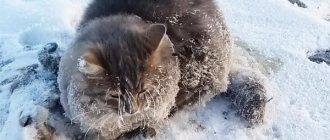Physiological causes of trembling or shaking, as with chills
If the dog is shaking with small tremors, then the process is not necessarily associated with a disease. Physiological manifestations are characterized by the rapid disappearance of symptoms after the elimination of the suspected factor causing them.
Scared puppy
Sources of the condition include stress, hypothermia, fear or nervous overexcitation. In hot weather, the anomaly can be caused by prolonged exposure to direct sunlight and heat stroke.
Cold and hypothermia
In some cases, the dog shakes after a long walk in the cold. The problem is more common in pets with short hair or miniature dogs that begin to shiver from the cold. It manifests itself as a small shaking, the animal begins to tuck its paws and tail. In this way, the body tries to normalize thermoregulation through muscle contractions.
Important! A similar phenomenon can be observed after bathing: if the house is cool, the animal may freeze and is trying to warm up. After water treatments, you need to wrap your pet in a thick towel, remove excess water and dry the fur with a hairdryer.
Hypothermia and warming up the dog
Prenatal and postpartum tremors
Childbirth is one of the most complex physiological processes. Why do dogs shake during labor:
- due to pushing and contractions;
- reducing temperature indicators;
- strong emotions.
In the postpartum period, tremor is provoked by:
- weakness;
- stress;
- anesthesia after surgery;
- increased temperature;
- hormonal imbalance.
Important! If the dog is not only shaking, but also has secondary symptoms, this means there is a risk of postpartum complications.
To determine the source of the deviation, you must consult a veterinarian.
Basic knowledge about dog health
In order for your Yorkshire Terrier to have every chance of avoiding most diseases, you need to monitor its health and feed it properly. For a dog of this breed, not only the correct balance in the diet is important, but also a sufficient amount of vitamins.
If you feed your pet with ready-made food, then you need to buy only high-quality food. Unlike cheap brands, these foods contain a full range of vitamins, minerals and other vital substances.
If your Yorkie's diet consists of natural food, you need to know what vitamins are contained in a particular product. Here are some examples:
In addition to natural food, you will also have to add multivitamins to your Yorkshire Terrier's food. “Trivit” with a high content of vitamins A, D, E is perfect.
But not a single animal is immune from any disease. Let's look at the most common diseases of Yorkshire terriers.
Why the dog shakes: psychological reasons
With physiological manifestations, tremor in dogs is not dangerous. It disappears along with the departure of the source of irritation.
Stress factors
The cat is breathing frequently: reasons and how you can help
The dog is trembling under the influence of strong emotions:
- fright;
- unrest;
- fear;
- anxiety;
- joy.
They promote the production of adrenaline and cortisone, substances related to stress hormones. Under their influence, metabolic processes accelerate, the heart contracts faster, and the nervous system is activated. Excessive amounts of hormones enter the muscles and the body gets rid of them through contractions of muscle tissue.
Important! If there are regular attempts to hide or unpredictable behavior on the street, or when seeing cars, the animal must be shown to a veterinarian.
The state of chronic stress is a dangerous phenomenon that leads to lethargy, drowsiness, and increased blood pressure. Under its influence, the functioning of the immune system is disrupted, blood glucose levels increase, and skin diseases develop.
Attempts to hide
Stress and anxiety
Trembling may appear when the owner returns home, in anticipation of a walk or treat, before a haircut, or when trying to attract attention. In this case, it is compared to involuntary wagging of the tail (the whole body) - a feature found in emotional pets or in those who have it docked.
Defensive reaction
Shakes the dog both during hypothermia and overheating. Sometimes the phenomenon occurs as a defensive reaction to pain, an unfamiliar place. Some animals express dissatisfaction in this way when traveling to a veterinary hospital.
Emotions: excitement, worry, fear
Unreasonable trembling practically does not occur; it is accompanied by certain factors:
- Stressed - the terrier tries to hide before being scolded or after being punished for mischief.
- Fear is a sharp sound, noise, or the appearance of a source of potential danger.
- Joy is excitement or anticipation of something pleasant.
Important! In Dachshund and Yorkie puppies, the phenomenon is associated with peculiarities of the psychological state or cunning.
In this case, the pet may squeal, flinch, or hunch over.
Tremor as a sign of disease
Trembling in dogs
- rapid rhythmic muscle contractions of individual parts of the body (for example, limbs) or the whole body, which the animal cannot control. Scientifically, trembling is called tremor. Tremor cannot be called an independent disease; rather, it is a symptom of some disease. Tremors most often occur in the following cases:
- Electrolyte imbalance.
The dog tucks its tail and trembles as if it were frozen. This happens with electrolyte imbalance, when the ratio of magnesium and potassium in the body is disturbed. The causes of this condition are often poor nutrition, as well as problems with the thyroid gland and kidneys. If there are problems with electrolyte metabolism in dogs, in addition to tremors, the following symptoms are observed: convulsions, a drop in blood pressure, pale mucous membranes, coldness of the extremities, irregular pulses, possible vomiting and a rise in temperature. In the clinic, a dog with this problem is given intravenous water-salt solutions;
Poisoning.
When a dog does not eat and is trembling, it can be assumed that it has been poisoned. Moreover, poisoning can be either food poisoning (eating expired foods, ingesting fertilizers, etc.) or non-food poisoning (snake bite, inhaling methane, etc.). Common signs of poisoning in addition to tremors include: convulsions and problems with coordination, excessive salivation, noisy breathing, increased blood pressure (more than 150/100), decreased temperature (less than 37 degrees), foaming from the nose or mouth, blueness or redness of mucous membranes , vomiting and diarrhea (with or without blood), dilated pupils. First aid can be provided to your dog at home if you are sure that the cause of the poisoning is eating stale food. The owner should provide a flow of fresh air into the room where the dog is, and then induce vomiting and then give an absorbent (activated carbon, Phosphalugel, etc.). If the cause of poisoning is not clear, you need to urgently take your pet to a veterinary hospital;
Pathological causes of trembling in dogs
Why does your Yorkie tremble at home and stick out its tongue: reasons
The occurrence of symptoms without visible prerequisites requires careful attention to the pet. A developing disease is indicated by involuntary lacrimation, sneezing, runny nose, digestive disorders and refusal to eat. The four-legged animal needs a full diagnostic examination and a course of therapy.
Important! If one or both legs of a young animal are shaking, then the symptoms may indicate hypovitaminosis.
Heatstroke
Disruption of heat exchange, caused by prolonged exposure to the scorching rays of the sun or in a hot, stuffy room, also causes a condition in which the dog is shaking. Additional signs of heatstroke include shortness of breath, lethargy, and indifference. The animal may feel sick and feel like it is freezing.
Heatstroke
Viral diseases
The causes of trembling in a dog include an increase in temperature associated with the penetration of pathogenic microflora into the body. The disease leads to sudden changes in behavior, a decrease in the amount of food, attempts to sleep more and move less.
Associated clinical manifestations of viral diseases include:
- salivation;
- dyspeptic disorders with vomiting, diarrhea or constipation;
- change in the usual color of the mucous membranes;
- refusal of food and treats;
- high or low temperature;
- lacrimation and rhinitis;
- rapid breathing.
General symptoms can indicate a common ARVI or a serious illness, even death.
Important! The same clinical picture is observed in animals with cardiovascular diseases.
Myocarditis (inflammation of the heart muscle) is manifested by rapid heartbeat, short-term loss of consciousness, and the pet’s legs may give way.
Leptospirosis in a dog
Viral hepatitis
The pathology affects puppies and young animals up to the first year of life. The disease leads to disruption of the normal functionality of the liver, externally manifests itself:
- tremor;
- shortness of breath;
- impaired coordination of movements;
- paralysis of the hind or forelimbs - due to poisoning of the body with decay products or damage to the nervous system.
Important! Self-medication in this case will lead to a deterioration in the condition and death of the animal. The pet needs to be shown to a veterinarian and undergo a full course of therapy.
Worm infestation
Chills in a dog can be caused by a variety of parasites:
- worms;
- helminths;
- simple microorganisms.
Infection and lack of anthelmintic treatment leads to the pet shaking during bowel movements. He refuses food and favorite treats, becomes apathetic and lethargic.
Helminthiasis becomes a source of:
- temperature rise;
- hair loss and dullness;
- dermatitis;
- flatulence;
- vomiting and diarrhea.
Important! Persistent skin itching can also be a symptom of helminthic infestations.
Carnivore plague
Penetration of the pathogen leads to inflammation of the tissues of the brain, liver and kidneys. The dog is breathing heavily and periodically shaking due to the high temperature, accompanying signs of pathology appear:
- photophobia;
- shortness of breath;
- vomiting and diarrhea;
- lacrimation and rhinitis.
Important! The disease lasts from 21 days to 3 months, the outcome depends on the state of immunity and the age of the pet. In severe cases it ends in death.
Distemper in a dog
Allergy
Why does the puppy tremble involuntarily: the condition occurs with allergic reactions associated with:
- with transfer to a new type of nutrition;
- reaction to medications;
- damage by ticks;
- during active flowering.
Obvious signs of an allergy include:
- dermatological itching;
- redness of the whites of the eyes;
- lacrimation and rhinitis;
- shortness of breath;
- shaking the head due to fluid accumulation in the ears.
Important! For a quick recovery, you need to find the source of the allergy and remove it from the apartment. If it cannot be identified, the pet will have to undergo diagnostics to determine the cause of the non-standard reaction.
Parvovirus enteritis
The disease occurs in babies up to 4 months, and occasionally in mature individuals. Manifested by vomiting, refusal of water and food. In the absence of emergency treatment, the chances of death increase every day.
Encephalomyelitis
It is registered in animals 5-8 years old. It is determined by muscle relaxation and loss of orientation in space. If the signs are ignored, the animal develops complete paralysis, due to which it will lie motionless until the end.
Dirofilariasis
The pathology is formed when dirofilaria enters the body, which gradually moves to the area of the animal’s heart. Signs of damage include:
- swelling of tissues;
- dry cough on inspiration;
- apathy and indifference to external stimuli;
- long sleep.
Important! The chances of recovery depend on the speed at which pathology is determined and therapy.
Adenovirus
Characterized by cough and fever. With a correctly prescribed course of therapy, recovery occurs within 2 weeks. For several months the animal remains a carrier of the infection.
Dog cough
Food or chemical poisoning
Spontaneous muscle contractions and indigestion, with vomiting and diarrhea, indicate intoxication of the body. Secondary symptoms of poisoning include:
- persistent thirst;
- lack of appetite;
- heavy breathing;
- apathy;
- constantly open mouth and hot nose.
Important! Therapy is prescribed only by a veterinarian, who finds medications in accordance with the type of toxic substance.
Hypoglycemia
Regular drops in blood sugar levels are associated with dysfunction:
- endocrine department;
- pancreas;
- liver.
This condition can occur during prolonged fasting or severe stress. In addition to trembling paws, the pet exhibits non-stop salivation, diarrhea, indifference, denial of food, convulsive syndrome, he tries to lie down, not walk, whine and attract attention. Attacks do not happen once - the animal’s body may be predisposed to a sharp drop in blood glucose.
Important! The owner must know the basics of first aid: the pet is given sweet water with natural honey or sugar.
Why did the dog start to tremble after vaccination, what should I do?
Almost all dog vaccinations have side effects. You can talk about their appearance if, after vaccination, a puppy or an adult pet shakes, refuses to eat, and becomes weak and lethargic. This is just the dog’s body’s reaction to the vaccine. The intensity of negative consequences after vaccination depends on the age of the dog and the characteristics of its body.
The trembling and lethargy usually go away on their own. If after vaccination the pet’s condition worsens, you should not ignore this phenomenon, as this can lead to the death of your four-legged friend. To prevent the dog from becoming ill after vaccination, the procedure must be carried out in a trusted veterinary clinic, properly prepare the dog for vaccination and strictly follow the recommendations for caring for the vaccinated animal.
If the trembling is due to physiological reasons, it is enough to eliminate their influence:
- Wear your pet warm clothes for walks in the cold season or limit their duration.
- Dry the coat thoroughly after bathing, possibly even using a hair dryer.
- Protect the dog from stressful situations, and in case of strong feelings, use tea with a calming effect.
Important! If during a walk or immediately after returning, the dog’s limb muscles begin to twitch significantly and sharply, this is one of the symptoms of strychnine poisoning. In this case, it is important to take the dog to the doctor as quickly as possible, since only emergency measures will save the pet’s life.
If the trembling lasts for a long time, in order to establish the cause of this phenomenon, you should consult a veterinarian and undergo the necessary examinations and tests. Only after this the veterinarian will determine the cause and prescribe the appropriate treatment:
- For allergic reactions: elimination of allergens and antihistamines.
- For helminthic infestations: deworming with special drugs, limiting contact with people until cure, since worms are transmitted to him.
- For hypoglycemia: glucose injections, but in advanced cases more serious treatment is required.
- For inflammation of the spinal cord: antibiotics with novocaine, compresses, massages.
- For adenovirus: antibiotics, amoxicillin, mucolytic drugs to relieve cough.
- For paraviral enteritis: immunoglobulins and immunomodulators, hyperimmune serum, water-salt solutions.
- For viral hepatitis: immunostimulants, hyperimmune serum and vitamins.
- For piroplasmosis: injections with antiviral vaccines, maintenance treatment.
- For pain syndromes: if the injury or wound is minor, the dog is able to lick the wound himself, and the owner only needs to make sure that there is no suppuration. If you have serious injuries or no external damage, you should consult a doctor for treatment.
The main thing is not to delay a visit to a specialist for too long, since detection of the disease at an early stage is usually easy to treat, while advanced forms require long-term treatment, and its outcome is not always favorable.
You can also contact our site's staff veterinarian, who will respond to them as soon as possible in the comment box below.
How to help your pet
After giving birth, a cat often breathes with its mouth open
Only after determining the source of the non-standard condition can auxiliary measures begin. Veterinarians emphasize that self-treatment causes more harm than it provides real help. With a pathological form of tremors, professional diagnosis and a full course of therapy are necessary.
At the veterinarian's appointment
If the problem is based on physiological etiology, then the situation can be corrected:
- If the pet is hypothermic, wrap it in a warm blanket and drink broth.
- If it overheats, take it to a cool room and let it lick an ice cube.
- In stressful situations, they talk to the dog in a calm voice, pet him and try in every possible way to calm him down.
To prevent hypothermia, short-haired and miniature breeds need to purchase special clothing designed for the autumn-winter season. Walking is reduced to a minimum, especially in severe frosts.
Important! You should not treat a trembling lower jaw in elderly pets. For them, this condition is within the normal range and does not require auxiliary therapy.
Why does the Yorkshire Terrier tremble: an overview of the main causes and solutions
Trembling in small dogs, including the Yorkshire Terrier, can be natural or pathological.
Yorkies are a small breed that are particularly gentle and require proper handling.
Their trembling can be caused by cold, stress, pregnancy and illness.
The owner, especially if he got a Yorkshire Terrier for the first time, may not understand what is happening to his pet.
When the cause of the problem cannot be determined, or if the dog begins to show symptoms of health problems, it must be taken to a veterinarian immediately.
Definition of tremors
Trembling (tremor) is a muscle reaction to certain processes occurring in the body. This could be a strong desire to eat, sexual desire, fatigue, illness, reaction to cold, defense.
Small rocks tremble even from a loud knock or thunderclap. In the case of miniature dogs, you should be more attentive to their fears. If a Spitz or Chihuahua is frightened by a loud noise, they may not only tremble, but also run away from the house.
Attention! If tremors persist, a visit to the veterinarian should not be postponed.











